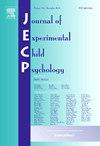Twins and virtual twins: Comparative analysis of problem behaviors
IF 1.8
2区 心理学
Q3 PSYCHOLOGY, DEVELOPMENTAL
引用次数: 0
Abstract
A study of factors affecting children’s problem behaviors using two unique sibships, monozygotic twins adopted together from China (MZ-CTT twins) and virtual twins (same-age unrelated siblings reared together; VTs), is presented. MZ-CTT twins share genes and environments, whereas VTs share environments only, allowing assessment of how these factors influence behavioral difficulties. Participants (MZ-CTT: n = 43 pairs; VT: n = 41 pairs) were in ongoing studies of behavioral development at the Twin Studies Center at California State University, Fullerton. Mean ages were 7.00 years (SD = 2.59) for MZ-CTT pairs and 6.24 years (SD = 2.26) for VT pairs; MZ-CTT pairs were significantly (albeit only slightly) older. Parents completed demographic surveys and the Child Behavior Checklist for each child. The greater resemblance of age- and sex-corrected t scores of MZ-CTT pairs across Internalizing, Externalizing, and Total problem behavior scales (ris = .72, .71, and .77, respectively) compared with VT pair scores (ris = .25, .40, and .63, respectively) demonstrates genetic influence on these measures. VT pairs with a biological child and an adoptee showed greater resemblance than those with two adoptees. This probably reflects the correlation of biological children’s genotype with the adoptees’ environment. Regression analyses revealed that for MZ-CTT pairs less variance in problem behaviors was explained by parental variables, such as maternal education, relative to VT pairs. This result may speak to the greater heterogeneity of the backgrounds of VT participants. In summary, this study of two unique kinships shows that both genetic and environmental factors influence child behavioral problems. Future studies using novel and informative kinships are warranted.
双胞胎和虚拟双胞胎:问题行为的比较分析
儿童问题行为影响因素的研究采用两个独特的兄弟姐妹,从中国一起收养的同卵双胞胎(MZ-CTT双胞胎)和虚拟双胞胎(同龄无血缘关系的兄弟姐妹一起抚养;VTs),呈现。MZ-CTT双胞胎共享基因和环境,而VTs只共享环境,从而可以评估这些因素如何影响行为困难。参与者(MZ-CTT: n = 43对;加州州立大学富勒顿分校的双胞胎研究中心正在进行行为发展的研究。MZ-CTT组的平均年龄为7.00岁(SD = 2.59), VT组的平均年龄为6.24岁(SD = 2.26);MZ-CTT对明显(尽管只有一点点)老化。家长们为每个孩子完成了人口统计调查和儿童行为检查表。在内化、外化和总问题行为量表上,年龄和性别校正后的MZ-CTT对的t得分(ris分别为0.72、0.71和0.77)与VT对的得分(ris分别为0.25、0.40和0.63)相比具有更大的相似性,这表明遗传对这些措施有影响。有亲生子女和被收养者的VT配对比有两个被收养者的VT配对更相似。这可能反映了亲生子女的基因型与被收养人所处环境的相关性。回归分析显示,与VT配对相比,MZ-CTT配对的问题行为差异较小,父母变量(如母亲受教育程度)可以解释问题行为的差异。这一结果可能说明了VT参与者的背景具有更大的异质性。总之,这项对两种独特的亲属关系的研究表明,遗传和环境因素都会影响儿童的行为问题。未来的研究使用新颖的和信息丰富的亲属关系是必要的。
本文章由计算机程序翻译,如有差异,请以英文原文为准。
求助全文
约1分钟内获得全文
求助全文
来源期刊

Journal of Experimental Child Psychology
Multiple-
CiteScore
4.50
自引率
7.70%
发文量
190
期刊介绍:
The Journal of Experimental Child Psychology is an excellent source of information concerning all aspects of the development of children. It includes empirical psychological research on cognitive, social/emotional, and physical development. In addition, the journal periodically publishes Special Topic issues.
 求助内容:
求助内容: 应助结果提醒方式:
应助结果提醒方式:


